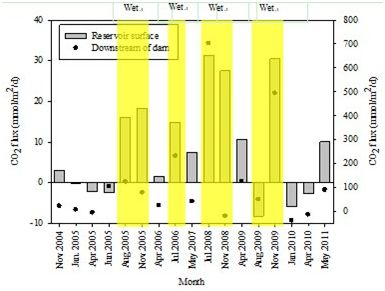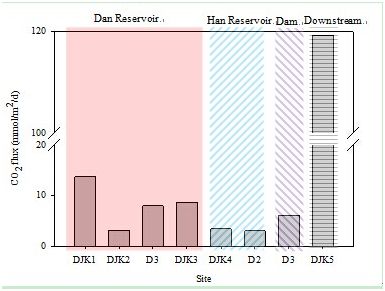
Research Reveals Water-air Interface CO2 Emission in Danjiangkou Reservoir
Aug 27, 2014 Email"> PrintText Size

Hydroelectric reservoirs have been increasingly concerned with respect to their contributions to greenhouse gas (GHG) emissions which are poorly understood due to data paucity particularly in monsoon region.
Danjiangkou Reservoir is situated in the Han River, which is one of the largest tributary of the Yangtze. The Reservoir is a major hydroelectric reservoir with typical geomorphological and hydro-climatological characteristics such as the location in a mountain area, subtropical monsoon climate and drastic shifts in seasonal drawdown zone. It could be representative of a typical case in the temperate zone where China's hydropower reservoirs are concentrated.
Dr. LI Siyue, supervised by Prof. ZHANG Quanfa from Wuhan Botanical Garden, examined the spatiotemporal changes of the carbonate system and CO2 flux of Danjiankou Reservoir in the subtropical monsoon climate region. A total of 21 field surveys conducted during 2004-2011 revealed significant spatial and monthly variations of aqueous partial pressure of CO2 (pCO2 ) in the Reservoir.
CO2 outgassing flux across the water-air interface in the Danjiangkou Reservoir was 1/13 lower than the flux from the river downstream the dam. Average CO2 flux and annual CO2 emission from the Reservoir were respectively 9 m mol m-2 d-1 and 3.4×109 mol Cy-1.
Seasonal hydrology exerted the first-order control on substantial monthly variations in pCO2 and CO2 flux, while biological CO2 uptake through aquatic photosynthesis dominated their spatial distributions in the Reservoir. The much higher CO2 flux in the river downstream the Reservoir was due to inherent water release for power generation. Correlative analyses demonstrated that pCO2 had strong positive correlations with Si and P speciations, TOC and DOC, negative correlations with DO saturation, TN and Chl-a.
Information in the spatial and temporal variability in CO2 flux from China’s hydroelectric reservoirs needs to be urgently included for revision of global models of reservoirs’ carbon emissions.
Results entitled “Partial pressure of CO2 and CO2 emission in a monsoon-driven hydroelectric reservoir (Danjiangkou Reservoir), China” were published in Ecological Engineering. The research is funded by the National Natural Science Foundation of China and the Youth Innovation Promotion Association of the Chinese Academy of Sciences.


Monthly and spatial variations of CO2 diffusion fluxes in the Danjiangkou Reservoir, China (Image by Dr. LI Siyue)
Hydroelectric reservoirs have been increasingly concerned with respect to their contributions to greenhouse gas (GHG) emissions which are poorly understood due to data paucity particularly in monsoon region.
Danjiangkou Reservoir is situated in the Han River, which is one of the largest tributary of the Yangtze. The Reservoir is a major hydroelectric reservoir with typical geomorphological and hydro-climatological characteristics such as the location in a mountain area, subtropical monsoon climate and drastic shifts in seasonal drawdown zone. It could be representative of a typical case in the temperate zone where China's hydropower reservoirs are concentrated.
Dr. LI Siyue, supervised by Prof. ZHANG Quanfa from Wuhan Botanical Garden, examined the spatiotemporal changes of the carbonate system and CO2 flux of Danjiankou Reservoir in the subtropical monsoon climate region. A total of 21 field surveys conducted during 2004-2011 revealed significant spatial and monthly variations of aqueous partial pressure of CO2 (pCO2 ) in the Reservoir.
CO2 outgassing flux across the water-air interface in the Danjiangkou Reservoir was 1/13 lower than the flux from the river downstream the dam. Average CO2 flux and annual CO2 emission from the Reservoir were respectively 9 m mol m-2 d-1 and 3.4×109 mol Cy-1.
Seasonal hydrology exerted the first-order control on substantial monthly variations in pCO2 and CO2 flux, while biological CO2 uptake through aquatic photosynthesis dominated their spatial distributions in the Reservoir. The much higher CO2 flux in the river downstream the Reservoir was due to inherent water release for power generation. Correlative analyses demonstrated that pCO2 had strong positive correlations with Si and P speciations, TOC and DOC, negative correlations with DO saturation, TN and Chl-a.
Information in the spatial and temporal variability in CO2 flux from China’s hydroelectric reservoirs needs to be urgently included for revision of global models of reservoirs’ carbon emissions.
Results entitled “Partial pressure of CO2 and CO2 emission in a monsoon-driven hydroelectric reservoir (Danjiangkou Reservoir), China” were published in Ecological Engineering. The research is funded by the National Natural Science Foundation of China and the Youth Innovation Promotion Association of the Chinese Academy of Sciences.


Monthly and spatial variations of CO2 diffusion fluxes in the Danjiangkou Reservoir, China (Image by Dr. LI Siyue)
CAS Institutes
There are 124 Institutions directly under the CAS by the end of 2012, with 104 research institutes, five universities & supporting organizations, 12 management organizations that consist of the headquarters and branches, and three other units. Moreover, there are 25 legal entities affiliated and 22 CAS invested holding enterprisesThere are 124 I...>> more
Contact Us

Chinese Academy of Sciences
Add: 52 Sanlihe Rd., Xicheng District, Beijing, China
Postcode: 100864
Tel: 86-10-68597592 (day) 86-10-68597289 (night)
Fax: 86-10-68511095 (day) 86-10-68512458 (night)
E-mail: cas_en@cas.cn

